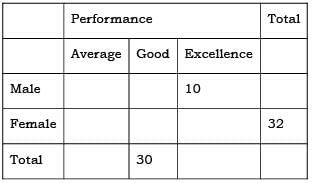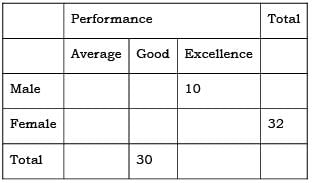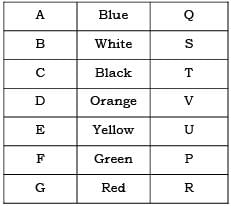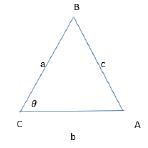UPSC CSE Prelims Paper 2 Practice Test - 9 - UPSC MCQ
30 Questions MCQ Test - UPSC CSE Prelims Paper 2 Practice Test - 9
The sum of the factors of a number is 124. What is the number?
Read the information given below carefully and answer.
Cyber vulnerabilities within nuclear weapons systems and structures present a whole set of dangers and risks. At best, cyber insecurity in nuclear weapons systems is likely to undermine trust and confidence in military capabilities and in the nuclear weapons infrastructure. At worst, cyber attacks could lead to deliberate misinformation and the inadvertent launch of nuclear weapons.
Q. Which among the following is the most logical, rational and critical inference that can be made from the above passage?
Read the information given below carefully and answer.
Because of its accuracy in outlining the Earth‘s subsurface, the seismic-reflection method remains the most important tool in the search for petroleum reserves. In field practice, a subsurface is mapped by arranging a series of wave-train sources, such as small dynamite explosions, in a grid pattern. As each source is activated, it generates a wave train that moves downward at a speed determined uniquely by the rock‘s elastic characteristics. As rock interfaces are crossed, the elastic characteristics encountered generally change abruptly, which causes part of the energy to be reflected back to the surface, where it is recorded by seismic instruments. The seismic records must be processed to correct for positional differences between the source and the receiver, for unrelated wave trains, and for multiple reflections from the rock interfaces. Then the data acquired at each of the specific source locations are combined to generate a physical profile of the subsurface, which can eventually be used to select targets for drilling.
Q. The passage is primarily concerned with
A professor keeps data on students tabulated by performance and sex of the student. The data is kept on computer disk, but unfortunately score of it is lost, because of virus. Only following could be recovered.

An expert committee was formed, which decided that following facts were self-evident.
1. 1/3rd of the male students were average.
2. Half the students were either excellent or good
3. 40% of the students were females.
Q. How many students are both male and good?
A professor keeps data on students tabulated by performance and sex of the student. The data is kept on computer disk, but unfortunately score of it is lost, because of virus. Only following could be recovered.

An expert committee was formed, which decided that following facts were self-evident.
1. 1/3rd of the male students were average.
2. Half the students were either excellent or good
3. 40% of the students were females.
Q. How many students were both female and excellent?
Find the lowest 4-digit number which when divided by 3, 4 or 5 leaves a remainder of 2 in each case?
Read the information given below carefully and answer.
Culture was not incorporated the Millennium Development Goals or their indicators, alleging numerous difficulties to measure its impact on development. However, one of the reasons why the goals set in the year 2000 were not met is probably the failure to explicitly recognize the role of culture in economic growth, resource management, conflict resolution, the approach to social inequities, or the reaffirmation of identities. Nor was it understood at the time that culture is an extremely effective vector for the transmission of knowledge and the basis for innovation and creation, including scientific breakthroughs. It was ignored, perhaps, that there is no one single development recipe, as cultures need to determine their development models, and not the other way around.
Q. Which of the following is the most rational inference from the above passage?
The ratio of a two-digit natural number to a number formed by reversing its digits is 4:7. Which of the following is the sum of all the numbers of all such pairs?
There are 15 students in art class and 37 students in dance class and 12 students are enrolled in both activities. When two classes meet at different hours find the number of students, who are either in art class or in dance class.
Read the information given below carefully and answer.
Digital technology has transformed the world we live in - disrupting entire industries and changing the social landscape. childhood is no exception. One in three internet users worldwide is a child, and young people are now the most connected of all age groups. From photos posted online to medical records stored in the cloud, many children have a digital footprint before they can even walk or talk. Digital technology can be a game changer for disadvantaged children, offering them new opportunities to learn, socialize and make their voices heard - or it can be yet another dividing line. Millions of children are left out of an increasingly connected world.
Q. Which of the following is most rational inference from the above passage?
Rajeev put his timepiece on the table in such a way that at 6 P.M. hour hand points to North. In which direction the minute hand will point at 9.15 P.M.?
(i) Seven types of paints A, B, C, D, E, F and G of different colours red, green, yellow, black, blue, white and orange are filled in different tins P, Q, R, S, T, U and V.
(ii) The order of the types of paints, colours and the tins is not necessarily in the same order.
(iii) Paint B is not kept in tins Q or R and is white in colour.
(iv) Paint D is kept in tin V and is not blue or red.
(v) F is kept in tin P and is green in colour.
(vi) Paints C and E are kept in tins T and U respectively and are black and yellow in colour respectively.
(vi) G is not blue in colour.
(vii) Red paint is not kept in tin Q.
Which of the following paints is orange in colour?
(i) Seven types of paints A, B, C, D, E, F and G of different colours red, green, yellow, black, blue, white and orange are filled in different tins P, Q, R, S, T, U and V.
(ii) The order of the types of paints, colours and the tins is not necessarily in the same order.
(iii) Paint B is not kept in tins Q or R and is white in colour.
(iv) Paint D is kept in tin V and is not blue or red.
(v) F is kept in tin P and is green in colour.
(vi) Paints C and E are kept in tins T and U respectively and are black and yellow in colour respectively.
(vi) G is not blue in colour.
(vii) Red paint is not kept in tin Q.
Paint B is kept in which tin?
Read the information given below carefully and answer the following question.
Almost a decade after the onset of the global financial crisis, national debt in advanced economies remains near its highest level since World War II, averaging 104 percent of GDP. Without measures either to cut spending or increase revenue, the situation will only get worse. As central banks abandon the extraordinary monetary measures, they adopted to battle the crisis, interest rates will inevitably rise from historic lows. That means interest payments will eat up a growing share of government spending, leaving less money to deliver public services or take steps to ensure long term economic growth, such as investing in infrastructure and education. Servicing debt will become a major burden.
This passage relates to
Direction: Five girls are sitting on a bench to be photographed. Sanju is to the left of Rashmi and to the right of Bipasha. Manu is to the right of Rashmi. Ritika is between Rashmi and Manu.
Who is sitting immediate right to Ritika?
Direction: Five girls are sitting on a bench to be photographed. Sanju is to the left of Rashmi and to the right of Bipasha. Manu is to the right of Rashmi. Ritika is between Rashmi and Manu.
Who is in the middle of the photograph?
In a certain code STUDYING is written as SGNIYDUT. How will SCALING be written in that code?
Read the information given below carefully and answer the following question.
The world faces a looming water disaster, one that could dry out our food systems. Even as climate change disrupts rainfall patterns, global water demand is projected to increase by 55% by 2050. While agriculture is not the only driver of increased water demand, the world's growing population will need more food, putting further strain on already limited water resources - resources that do not enter into the market value of the food on our plates. This scarcity of water can in turn cause shortage of food supply in the world.
Q. Which of the following is most rational inference from the above passage?
All the page numbers in a book are added, beginning from page 1. However, a page number was added twice by mistake. If the sum obtained was 850, which page number must have been added twice?
Two trains, travelling at 15 and 30 kms per hour, head directly towards each other. They begin at a distance of 60 kms from each other. How far apart are they (in kms) one minute before they collide?
Read the following 1 Passage and answer the items that follow. Your answers to these items should be based on the passages only.
Recently some scientists have concluded that meteorites found on Earth and long believed to have a Martian origin might actually have been blasted free of Mars’s gravity by the impact on Mars of other meteorites. This conclusion has led to another question whether meteorite impacts on Earth have similarly driven rocks from this planet to Mars. According to astronomer S. A. Phinney, kicking a rock hard enough to free it from Earth’s gravity would require a meteorite capable of making a crater more than 60 miles across. Moreover, even if Earth rocks were freed by meteorite impact, Mars’s orbit is much larger than Earth, So Phinney estimates that the probability of these rocks hitting Mars is about one-tenth as great as that of Mars’s rocks hitting Earth. To demonstrate this estimate, Phinney used a computer to calculate where 1,000 hypothetical particles would go if ejected from Earth in random directions. He found that 17 of the 1,000 particles would hit Mars.
Q. The Passage is primarily concerned with
Read the following 1 Passage and answer the items that follow. Your answers to these items should be based on the passages only.
Recently some scientists have concluded that meteorites found on Earth and long believed to have a Martian origin might actually have been blasted free of Mars’s gravity by the impact on Mars of other meteorites. This conclusion has led to another question whether meteorite impacts on Earth have similarly driven rocks from this planet to Mars. According to astronomer S. A. Phinney, kicking a rock hard enough to free it from Earth’s gravity would require a meteorite capable of making a crater more than 60 miles across. Moreover, even if Earth rocks were freed by meteorite impact, Mars’s orbit is much larger than Earth, So Phinney estimates that the probability of these rocks hitting Mars is about one-tenth as great as that of Mars’s rocks hitting Earth. To demonstrate this estimate, Phinney used a computer to calculate where 1,000 hypothetical particles would go if ejected from Earth in random directions. He found that 17 of the 1,000 particles would hit Mars.
Q. According to the passage, which of the following events may have initiated the process that led to the presence on Earth of meteorites from Mars?
If × stands for 'addition', ÷ stands for 'subtraction', + stands for 'multiplication' and - stands for 'division', then 20 × 8 ÷ 8 - 4 + 2 = ?
Each question given below is followed by two statements I and II Mark your answer as:
(a) If the question can be answered by using one of the statements alone, but cannot be answered by using the statement alone.
(b) if the question can be answered by using either of the statements alone.
(c) if the question can be answered by using both the statements together, but cannot be answered by using either of the statements alone.
(d) If the question cannot be answered even by using both the statements together.
Q. Two of the sides of a triangle are 6 cm and 8 cm. What is the length of the third side?
I. Area of the triangle is 24 cm2.
II. It is a right angled triangle.
Each question given below is followed by two statements I and II Mark your answer as:
(a) If the question can be answered by using one of the statements alone, but cannot be answered by using the statement alone.
(b) if the question can be answered by using either of the statements alone.
(c) if the question can be answered by using both the statements together, but cannot be answered by using either of the statements alone.
(d) If the question cannot be answered even by using both the statements together.
Q. If ‘X’ is an integer such that 10 < X < 100, what is the value of ‘X’?
I. One of the digits of ‘X’ is 4 more than the other, and the sum of its digits is 10.
II. X > 60.
Each question given below is followed by two statements I and II Mark your answer as:
(a) If the question can be answered by using one of the statements alone, but cannot be answered by using the statement alone.
(b) if the question can be answered by using either of the statements alone.
(c) if the question can be answered by using both the statements together, but cannot be answered by using either of the statements alone.
(d) If the question cannot be answered even by using both the statements together.
Q. The average salary for a month of the employees of an office is Rs 50,000. What is the number of employees (X) in the office?
І. Exclusion of the highest and the lowest earning members from the office does not change the average monthly salary of the employees.
ІІ. 100 < X< 1000.
Shalini bought a laptop for Rs. X and sold it to Rahul at a profit of 40%. Rahul used it for some time and then sold it to Sam at a loss of 20%, what would have been Rahul’s profit percent had he bought the laptop directly?
Sonu is brother of Neeraj. Neeraj is father of Rocky. Rocky is son of Puja. In term of relationship what is Sonu of Puja?
Find the next term in the series 101, 102, 104, 107 ....
There are 4 orange balls, 5 blue balls and 3 white balls are there in a bag. Two balls are selected at random. What is the probability of getting both the balls being blue?



























